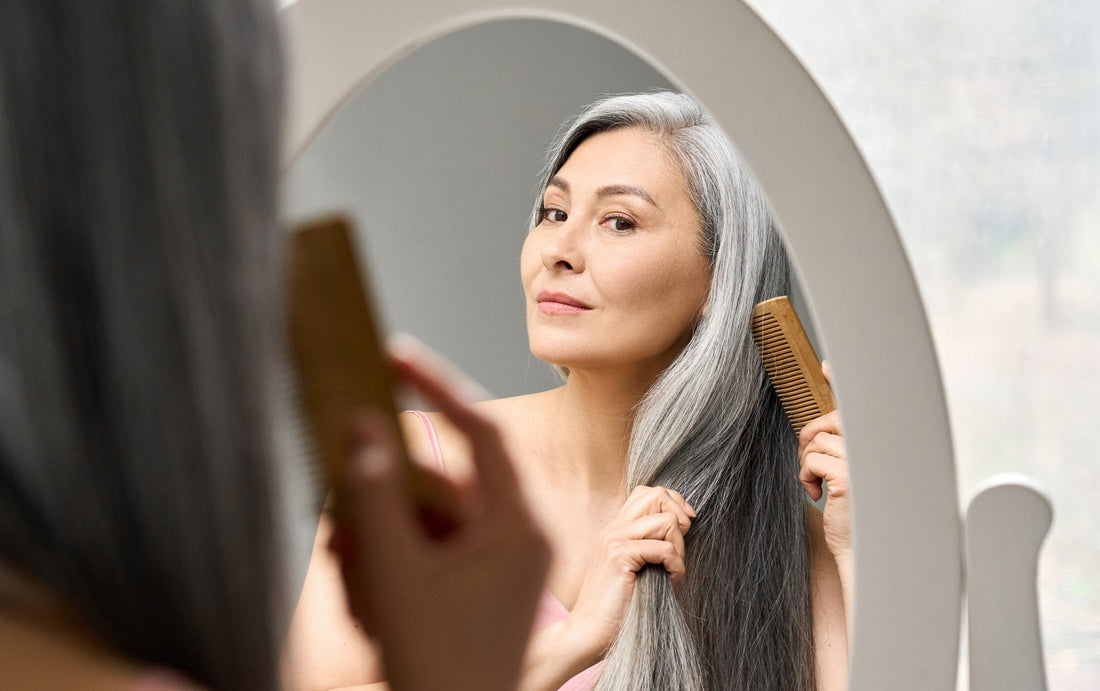
Does Menopause Cause Hair Loss? Understanding the Connection Between Hormones and Hair Health
Menopause is a transformative time in a woman’s life—physically, emotionally, and hormonally. While we often talk about hot flashes, mood changes, and sleep disruptions, there’s one symptom that tends to show up quietly but can affect self-esteem and daily confidence: hair loss.
If you’ve been asking yourself, “Why is my hair thinning?” or “Is menopause making my hair fall out?”—you’re not imagining it. The answer is yes: menopause can cause hair loss. Let’s unpack why this happens, what’s going on at the scalp level, and most importantly, how you can take back control.
What Happens to Hormones During Menopause?
Menopause typically begins between ages 45–55, though it can start earlier or later. It marks the end of menstrual cycles, but behind the scenes, it’s really about hormonal shifts—especially a significant drop in estrogen and progesterone levels.
These hormones aren’t just involved in reproduction; they play a critical role in regulating the hair growth cycle. Estrogen and progesterone help keep hair in its “growing” (anagen) phase longer, while keeping shedding (telogen) to a minimum. As their levels decline, hair follicles can miniaturize, grow more slowly, and shed more quickly.
At the same time, androgens (male hormones like testosterone) may become more dominant, which can shrink hair follicles—particularly around the crown or hairline. This pattern is known as female pattern hair loss or androgenic alopecia.

Signs of Menopausal Hair Loss
Hair loss during menopause doesn't always look the same. You might notice:
-
Thinning around the crown or part line
-
More hair in your brush or shower drain
-
Loss of volume and body
-
Hair becoming finer, drier, or more brittle
-
Slower hair growth overall
It’s worth noting that not all hair loss is hormone-related. Nutritional deficiencies, stress, thyroid issues, and certain medications can also be contributing factors.
What’s Happening at the Root?
Healthy hair starts at the root—and the scalp is a living, breathing ecosystem. With hormonal shifts, scalp health can become compromised, leading to inflammation, excess oil production, or increased sensitivity.
-
Sebum (oil) production can change, sometimes leading to clogged follicles.
-
Blood flow to the scalp may decrease, making it harder for follicles to get the nutrients they need.
-
The hair follicle cycle shortens, meaning hair sheds faster than it can regrow.
That’s why at Safo Hair, we always say: Hair wellness starts at the scalp.
How to Support Your Hair During Menopause
While menopause is a natural part of aging, hair thinning doesn’t have to be inevitable. Here are science-backed, scalp-forward strategies to help you nourish your follicles and protect your strands.
1. Feed Your Follicles
Hair thrives on nutrients like iron, biotin, vitamin D, zinc, and omega-3 fatty acids. A balanced diet or targeted supplements can help fill in nutritional gaps that often accompany menopause.
✨ Safo Tip: Look for plant-based, anti-inflammatory foods like leafy greens, avocados, seeds, and berries. What you eat shows up in your strands.
2. Rebalance the Scalp Microbiome
Just like your gut, your scalp has its own microbiome. When it’s out of balance, inflammation can lead to weakened follicles and poor hair retention.
✨ Use gentle, pH-balanced cleansers that support your scalp barrier without stripping it. Our Safo Hydrating Shampoo is sulfate-free and formulated to nourish textured, dry, or sensitive scalps.
3. Stimulate Circulation
Massaging your scalp daily with your fingers or a scalp brush can increase blood flow and oxygen to the roots—crucial for follicle vitality.
✨ Add a few drops of Safo Hair Oil to your fingertips and massage in circular motions. Bonus: it’s a calming ritual that doubles as self-care.
4. Use Targeted, Hormone-Safe Topicals
Look for products containing botanical actives known to support thinning hair, such as pumpkin seed oil, saw palmetto, rosemary extract, caffeine, or peptides. These ingredients may help block DHT (a testosterone byproduct) and encourage new growth.
✨ Safo’s upcoming Follicle Activating Serum is designed with women’s wellness in mind—powered by clean, effective botanicals and free of hormone disruptors.
5. Manage Stress + Sleep
Stress and poor sleep both spike cortisol, which can push more follicles into the shedding phase. Prioritize rest, mindfulness, and movement to regulate your body’s stress response.

When to See a Professional
If you’re noticing sudden or extreme hair loss, it’s worth talking to a healthcare provider or trichologist. They can run hormone panels, thyroid tests, or check for deficiencies to get to the root of the issue.
You’re Not Alone—And You’re Not Powerless
Menopausal hair loss can be emotional, but it’s not something you have to accept without a fight. With the right knowledge, ingredients, and care, you can support your hair’s health from the inside out—and embrace every stage of womanhood with strength, confidence, and yes, beautiful hair.
At Safo Hair, we’re here to walk with you on your hair wellness journey. Because your crown deserves care—at every age, every texture, every phase.
Want more tips on supporting your hair through hormonal changes?
Sign up for our newsletter for exclusive content, early access to new products, and expert advice tailored to women’s hair health.

